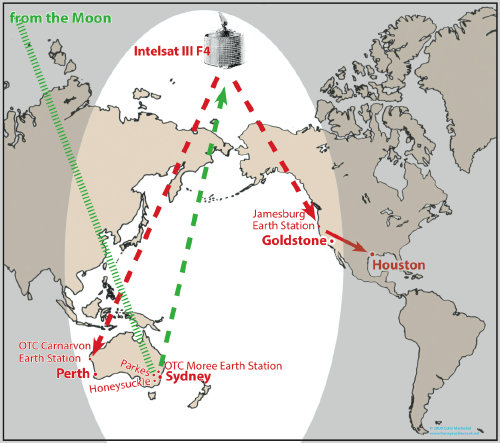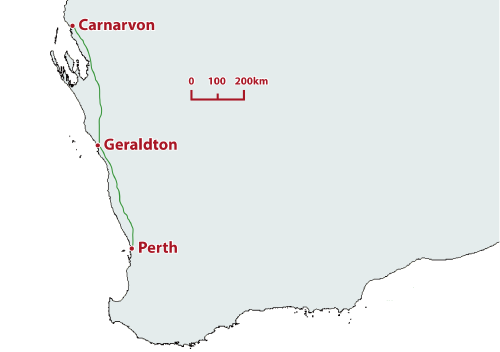Viewers in Western Australia didn’t expect to see
the Apollo 11 Moonwalk live.
In 1969, there was no East–West microwave link to bring live TV from the Eastern states. This meant that Western Australia would be one of the few places in the western world to miss out on seeing the Moonwalk as it happened. Engineers at the Australian Broadcasting Commission in Perth devised a way to change that.
The OTC Earth Station at Carnarvon would be able to view the Honeysuckle Creek and Parkes television that was being broadcast from Sydney Video to the US. This signal was to be sent from OTC’s Moree Earth Station to the Intelsat III F4 satellite over the Pacific Ocean, from where it would be releayed to the Jamesburg Earth Station in California.
Since Intelsat III’s antenna had a beamwidth of 19 degrees (the Earth subtends 17.5 degrees at Geostationary distance) it provided global coverage. (This was before spot beams were used on satellites.) Any Earth Station within view of the Pacific satellite would be able to see whatever TV it was relaying. Further, Intelsat III series satellites could handle two television signals at the same time. Intelsat III F4 relayed both the outgoing TV from Australia and the return feed released from Houston. It was the outgoing signal originating in Australia which would provide, by far, the best quality TV.
|
TV from the Moon was relayed from Honeysuckle Creek and Parkes, via Sydney to the Moree Earth Station. From there it was transmitted to the Pacific Intelsat III satelllite. Any Earth Station which could see the satellite (i.e. anything in the highlighted area) could receive the TV intended for Jamesburg and then Houston.
Large, Larger. |
The OTC Carnarvon antenna would be relaying telemetry from the nearby NASA station via Intelsat III anyway. Indeed, this was the prime reason the OTC station was established. (The 42 foot cassegrain horn – dubbed OTC-1 – was used, the new 97 foot parabolic antenna was still under construction.)
In mid-1969 a new coaxial cable was being installed from Geraldton to Carnarvon, to service the planned ABC-TV transmitter at Carnarvon. (ABC-TV in Carnarvon went on air officially on 15 July 1972.) It was realised that this new coaxial cable could be used to bring TV from OTC Carnarvon to Perth. ABC Perth Senior Engineer TV Allan Hullett and his colleague Mike Altrea worked to make it a reality.
|
It’s a 425km drive from Perth to Geraldton and another 480km from Geraldton to Carnarvon. Click for a larger PDF version.
|
Arrangements were made with NASA and the OTC to release the television to Western Australian viewers – but for the TV to reach Perth, Postmasters General Department (PMG) technicians would have to reverse the repeaters all the way down the coaxial cable, and also equipment would have to be reconfigured at the OTC station. It was this reconfiguring at OTC-1 which was uncertain. In the days before Apollo 11, OTC was contracted to support the launch of a new Atlantic communications satellite. Thankfully, the launch was delayed long enough for the preparations to made.
Allan Hullett took a small team up to Carnarvon to co-ordinate the work. They began the 900km drive to Carnarvon on the day of the Apollo 11 launch, July 16, and on their arrival set up camp just outside the OTC station. NEC staff who were installing equipment at the new 97 foot OTC dish helped OTC, ABC and PMG technicians and engineers get everything up and running by Sunday July 20, the day before the landing.
Microwave links were set up from the OTC station to the Carnarvon Telephone Exchange, 5 kilometres away.
There, the TV was split. One feed went to a small 525 line / 60Hz capable TV monitor on the stage of Carnarvon’s Memorial Theatre where a large crowd of locals gathered to watch the picture. It was reported – see below– in Carnarvon’s Northern Times on 24 July 1969 that many came armed with binoculars to see the distant screen, with one man using the telescopic sight on his rifle.
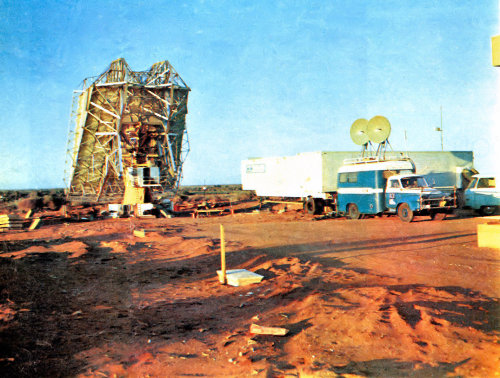 |
This photo of an ABC microwave van next to the OTC Carnarvon 42 foot antenna was taken in November 1966. The setup for the Apollo 11 TV relay would have been very similar. (Scan: Alan Gilham. From The Australian Women’s Weekly, 14th December 1966.) |
The TV was also sent down the coaxial cable to Perth where the 525 line / 30 frames per second TV was scan-converted to Australian standards (625 line / 25 fps) using a vidicon camera pointed at a long-persistence monitor.
The live Moonwalk TV was then distributed on the ABC-TV Western Australia network and was also provided to the commercial TV stations.
Thus, the momentous Apollo 11 Moonwalk was the first live television broadcast from outside Western Australia to be seen by the public.
 Listen to a 15 minute interview Listen to a 15 minute interview
(5.1MB mp3 file) with ABC-TV Senior Engineer Allan Hullett.
(recorded 08 May 2009.)
Photo: University of Western Australia. |
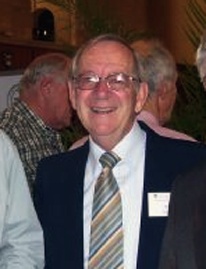 |
|
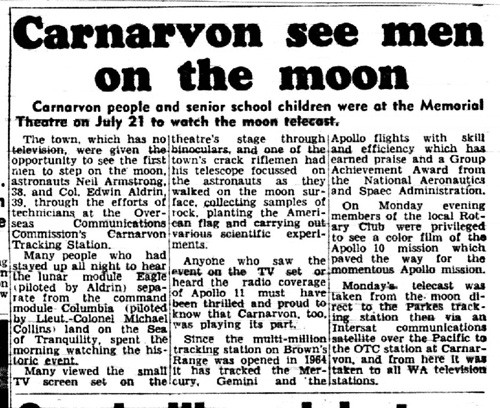 |
Paul Dench supplied this scan of an article from Carnarvon’s The Northern Times, 24 July 1969. |
(As well, the unconverted slow scan television direct from the lunar surface was seen in-house at the NASA Carnarvon Tracking Station, once the Moon rose at that location.)
With thanks to Allan Hullett (formerly ABC TV Perth) for his interview and to Paul Dench (formerly NASA Carnarvon Tracking Station) for the story, the Northern Times article, and the local TV start-up date. Illustrations and interview by Colin Mackellar.
Back to the main Apollo
11 TV page.
Back
to the main Apollo 11 mission page.
